Exploring the Effect of Varying Fiber Dosages as Stirrup Substitutes in Torsion-Loaded Concrete Beams
Abstract
:1. Introduction
2. Research Significance
3. Experimental Program
3.1. Apparatus
3.2. Materials and Mix Proportions
3.3. Mechanical Properties
3.4. Test Procedure
4. Results and Discussion
4.1. Cracking Patterns and Failure Modes
4.2. Torsional Strength and Torque–Twist Angle Performance
4.3. Torsional Toughness and Ductility Index
5. Conclusions
- The addition of SFs to the concrete mixture affects workability by reducing the concrete slump. Workability decreases with increasing SF length and dosage.
- Diagonal and twisting cracks were observed around the tested beam spans as the torsional load increased. In the steel FRC beams, one main crack was wider than the others, whereas the T-NCon beam exhibited multiple major cracks with increasing torque.
- The SF dosage of 0.5% failed to compensate for the absence of transverse reinforcement, leading to a reduction in ultimate torque capacities by 27%, 39%, and 42% for fiber lengths of 13 mm, 35 mm, and 60 mm, respectively, compared to the T-NCon beam.
- The optimal SF dosage for improving torsional behavior in the absence of transverse reinforcement was found to be 1.0% of the volume. This resulted in torque strength improvements of 11%, 6.8%, and 4.5% for fiber lengths of 13 mm, 35 mm, and 60 mm, respectively, compared to the T-NCon beam.
- With an SF dosage of 1.5%, the ultimate torque capacity increased by 19%, 32%, and 41% for fiber lengths of 13 mm, 35 mm, and 60 mm, respectively, compared to the T-NCon beam.
- The initial torsional rigidity of the steel FRC beams was comparable to that of the T-NCon beam, and it was dependent on the SF dosage and the presence of transverse reinforcement.
- The resistance to torsional cracking and crack width at failure in the steel FRC beams were influenced by the SF dosage and fiber length.
- For the SF dosage of 0.5%, increasing the number of SFs per volume for the 13 mm fiber length demonstrated greater improvement in torsional characteristics compared to fiber lengths of 35 mm and 60 mm.
Author Contributions
Funding
Data Availability Statement
Conflicts of Interest
References
- Zhou, M.; Lu, W.; Song, J.; Lee, G.C. Application of ultra-high performance concrete in bridge engineering. Constr. Build. Mater. 2018, 186, 1256–1267. [Google Scholar] [CrossRef]
- Yoo, D.-Y.; Yoon, Y.-S. A review on structural behavior. Design, and application of ultra-high-performance fiber-reinforced concrete. Int. J. Concr. Struct. Mater. 2016, 10, 125–142. [Google Scholar] [CrossRef] [Green Version]
- Yoo, D.-Y.; Banthia, N. Mechanical properties of ultra-high-performance fiber reinforced concrete: A review. Cem. Concr. Compos. 2016, 73, 267–280. [Google Scholar] [CrossRef]
- Zhu, Y.; Zhang, Y.; Hussein, H.H.; Chen, G. Flexural strengthening of reinforced concrete beams or slabs using ultra-high performance concrete (FRC): A state of the art review. Eng. Struct. 2020, 205, 110035. [Google Scholar] [CrossRef]
- Al-Salim, N.H.; Jaber, M.H.; Hassan, R.F.; Mohammed, N.S.; Hussein, H.H. Experimental Investigation of Compound Effect of Flexural and Torsion on Fiber-Reinforced Concrete Beams. Buildings 2023, 13, 1347. [Google Scholar] [CrossRef]
- Rahal, K.N.; Collins, M.P. Compatibility torsion in spandrel beams using modified compression field theory. ACI Struct. J. 2006, 103, 318–338. [Google Scholar]
- Foraboschi, P. Structural layout that takes full advantage of the capabilities and opportunities afforded by two-way RC floors, coupled with the selection of the best technique, to avoid serviceability failures. Eng. Fail. Anal. 2016, 70, 387–418. [Google Scholar] [CrossRef]
- Foraboschi, P. Bending load-carrying capacity of reinforced concrete beams subjected to premature failure. Materials 2019, 12, 3085. [Google Scholar] [CrossRef] [PubMed] [Green Version]
- Yoo, D.-Y.; Yoon, Y.-S.; Banthia, N. Flexural response of steel-fiber-reinforced concrete beams: Effects of strength, fiber content, and strain-rate. Cem. Concr. Compos. 2015, 64, 84–92. [Google Scholar] [CrossRef]
- Hsu, T. Torsion of Structural Concrete Behavior of Reinforced Concrete Rectangular Members; Torsion of Structural Concrete, SP-18; American Concrete Institute: Indiana, IA, USA, 1968; pp. 261–306. [Google Scholar]
- Mahdi, H.M. Behavior of High Strength Self Compacted Hollow Section Reinforced Concrete Beams under Pure Torsion. Tikrit J. Eng. Sci. 2015, 22, 9–23. [Google Scholar] [CrossRef]
- Bernardo, L.; Lopes, S.; Teixeira, M. Experimental study on the torsional behavior of prestressed HSC hollow beams. Appl. Sci. Spec. Issue Archit. Struct. 2020, 10, 14. [Google Scholar]
- Rahal, K.N. Torsional strength of normal and high strength reinforced concrete beams. Eng. Struct. 2013, 56, 2206–2216. [Google Scholar] [CrossRef]
- Bernardo, L.F.A.; Lopes, S.M.R. Plastic analysis and twist capacity of high-strength concrete hollow beams under pure torsion. Eng. Struct. 2013, 49, 190–201. [Google Scholar] [CrossRef]
- ACI 318–14; Building Code Requirements for Structural Concrete and Commentary. Farmington Hills, American Concrete Institute: Indiana, IA, USA, 2014.
- GB 50010-2010; Code for Design of Concrete Structures. Beijing, General Administration of Quality Supervision, Inspection and Quarantine of the People’s Republic of China and Standardization Administration of the People’s Republic of China (AQSIQSAC): Beijing, China, 2015. (In Chinese)
- Ahmed, A.K.; Al-Sulayvany, B.J.; Jomma’h, M.M. Mechanical Characteristics of Lightweight Concrete Enhanced by Fly-Ash and Steel Fiber. Tikrit J. Eng. Sci. 2019, 26, 16–25. [Google Scholar] [CrossRef]
- Rao, T.D.G.; Seshu, D.R. Torsion of steel fiber reinforced concrete members. Cem. Concr. Res. 2003, 33, 1783–1788. [Google Scholar] [CrossRef]
- Rao, T.D.G.; Seshu, D.R. Torsional response of fibrous reinforced concrete members: Effect of single type of reinforcement. Constr. Build. Mater. 2006, 20, 187–192. [Google Scholar] [CrossRef]
- Chalioris, C.; Karayannis, C. Effectiveness of the use of steel fibers on the torsional behaviors of flanged concrete beams. Cem. Concr. Compos. 2009, 31, 331–341. [Google Scholar] [CrossRef]
- Okay, F.; Engin, S. Torsional behavior of steel fiber reinforced concrete beams. Constr. Build. Mater. 2012, 28, 269–275. [Google Scholar] [CrossRef]
- Hassan, R.F.; Jaber, M.H.; Al-Salim, N.H.; Hussein, H.H. Experimental research on torsional strength of synthetic/steel fiber-reinforced hollow concrete beam. Eng. Struct. 2020, 220, 110948. [Google Scholar] [CrossRef]
- Hassan, R.F.; Al-Salim, N.H.; Mohammed, N.S.; Hussein, H.H. Experimental study and theoretical prediction on torsional strength with different steel fiber reinforced concretes and Cross-Section areas. Eng. Struct. 2022, 251, 113559. [Google Scholar] [CrossRef]
- Rao, T.D.G.; Rama Seshu, D. Analytical model for the torsional response of steel fiber reinforced concrete members under pure torsion. Cem. Concr. Compos. 2005, 27, 493–501. [Google Scholar] [CrossRef]
- Ju, H.; Lee, D.H.; Hwang, J.-H.; Kang, J.W.; Kim, K.S.; Oh, Y.H. Torsional behavior model of steel-fiber-reinforced concrete members modifying fixed-angle softened-truss model. Compos. Part B 2013, 45, 215–231. [Google Scholar] [CrossRef]
- Bernardo, L.F.A.; Teixeira, M.M. Modified softened truss-model for prestressed concrete beams under torsion. J. Build. Eng. 2018, 19, 49–61. [Google Scholar] [CrossRef]
- Yang, I.-H.; Joh, C.; Lee, J.W.; Kim, B.-S. Torsional behavior of ultra-high performance concrete squared beams. Eng. Struct. 2013, 56, 372–383. [Google Scholar] [CrossRef]
- Ismail, M. Behavior of FRC Structural Members Subjected to Pure Torsion. Ph.D. Dissertation, Kassel University, Kassel, Germany, 2015. [Google Scholar]
- Al Khuzaie, H.; Atea, R. Investigation of torsional behaviors and capacity of reactive powder concrete (RPC) of hollow T-beam. J. Mater. Res. Tech. 2019, 8, 199–207. [Google Scholar] [CrossRef]
- Oettel, V.; Empelmann, M. UHPFRC box girders under torsion. In Proceedings of the Hipermat 2012 3rd International Symposium on FRC and Nanotechnology for High Performance Construction Materials, Kassel, Germany, 7–9 March 2012; pp. 517–524. [Google Scholar]
- Kwahk, I.; Joh, C.; Lee, J.W. Torsional behavior design of FRC box beams based on thin-walled tube theory. Engineering 2015, 7, 101–114. [Google Scholar] [CrossRef] [Green Version]
- Zhou, J.-L.; Li, C.-X.; Feng, Z.; Yoo, D.-Y. Experimental investigation on torsional behaviors of ultra-high-performance fiber-reinforced concrete hollow beams. Cem. Concr. Compos. 2022, 129, 104504. [Google Scholar] [CrossRef]
- Zou, T. Analysis on Torsion Effect and Distortion Effect of Extra-Long-Span FRC Continuous Girder Bridge. Ph.D. Dissertation, Hunan University, Changsha, China, 2015. [Google Scholar]
- Xie, T.; Mohamed Ali, M.S.; Elchalakani, M.; David, M. Experimental and analytical study of ultrahigh-performance fiber-reinforced concrete curved beams. J. Struct. Eng. 2020, 146, 04019192. [Google Scholar] [CrossRef]
- Mohammed, T.J.; Abu Bakar, B.H.; Muhamad Bunnori, N. Torsional improvement of reinforced concrete beams using ultra high-performance fiber reinforced concrete (UHPFC) jackets—Experimental study. Constr. Build. Mater. 2016, 106, 533–542. [Google Scholar] [CrossRef]
- Iraqi Specification Standards IQS No. (5); Portland Cement. Central Agency for Standardization and Quality Control, Planning Council: Baghdad, Iraq, 1984. (In Arabic)
- ASTM C33-03; Standard Specification for Concrete Aggregates. ASTM International: West Conshohocken, PA, USA, 2003.
- ASTM Designation A615/A615M-01b; Standard Specifications for Deformed and Plain Billet-Steel Bars for Concrete Reinforcement. Annual Book of ASTM Standards. American Society for Testing and Materials: Philadelphia, PA, USA, 2001; Volume 1.04.
- ASTM C496; Standard Test Method for Splitting Strength for Cylindrical Concrete Specimens. American Society for Testing and Materials: Philadelphia, PA, USA, 2004.
- ASTM C78C78M–18; Standard Test Method for Flexural Strength of Concrete (Using Simple Beam with Third-Point Loading). ASTM: West Conshohocken, PA, USA, 2018.
- BSI. BS EN 12390-3; Testing Hardened Concrete. Compressive Strength of Test Specimen. BSI: London, UK, 2009.
- Hadi, M.N.; Khan, Q.S.; Sheikh, M.N. Axial and flexural behavior of unreinforced and FRP bar reinforced circular concrete filled FRP tube columns. Constr. Build. Mater. 2016, 122, 43–53. [Google Scholar] [CrossRef] [Green Version]
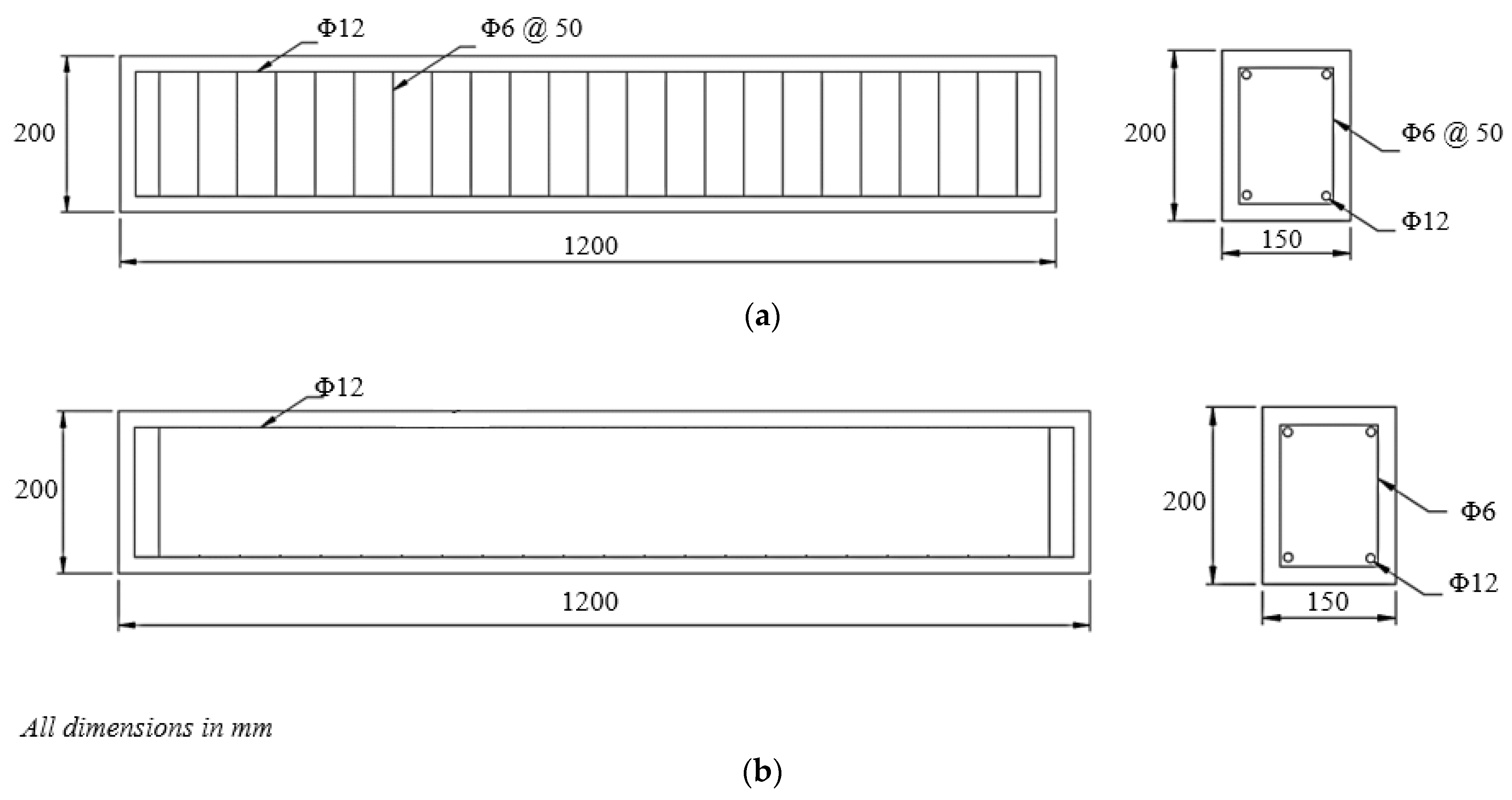



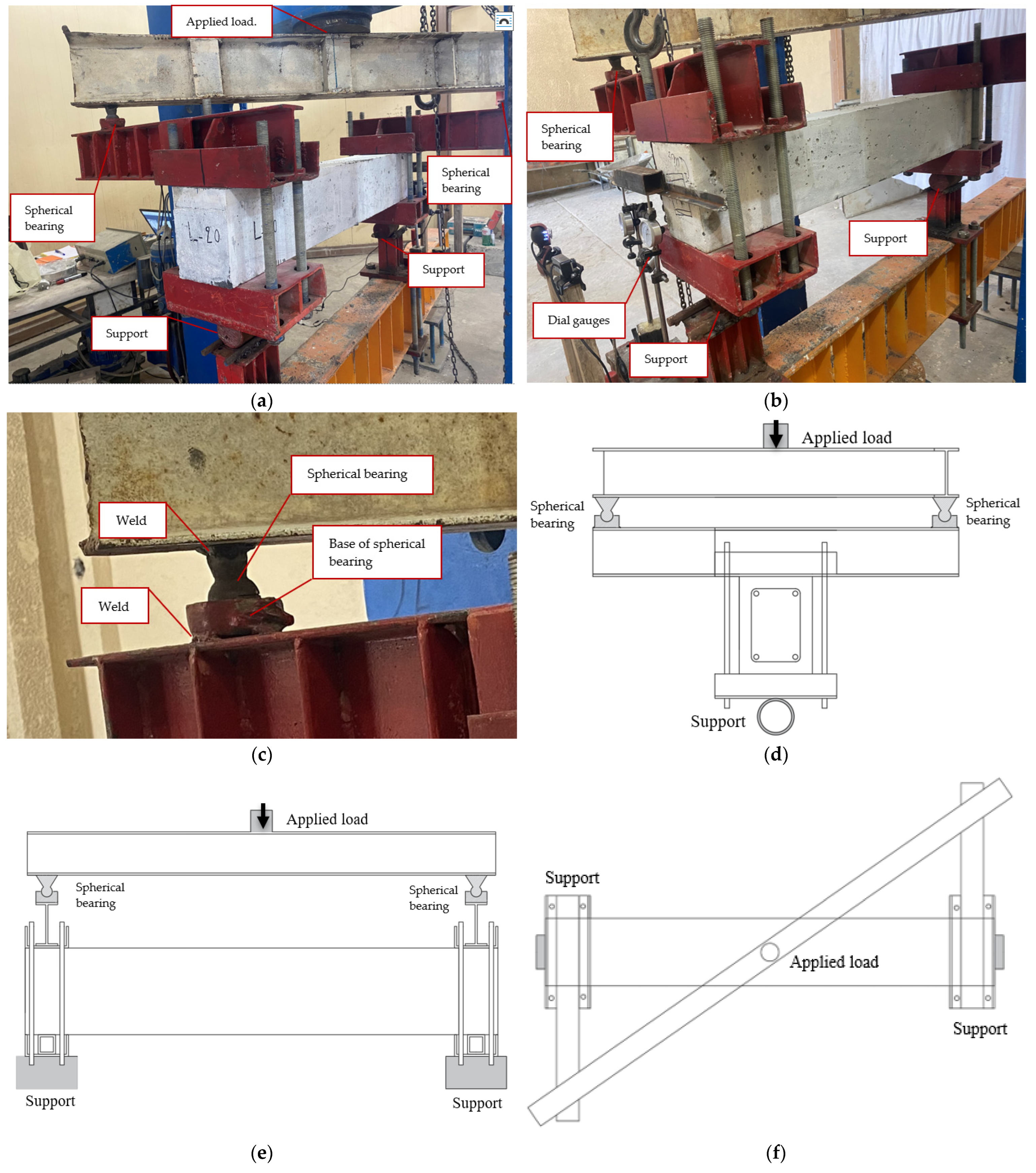
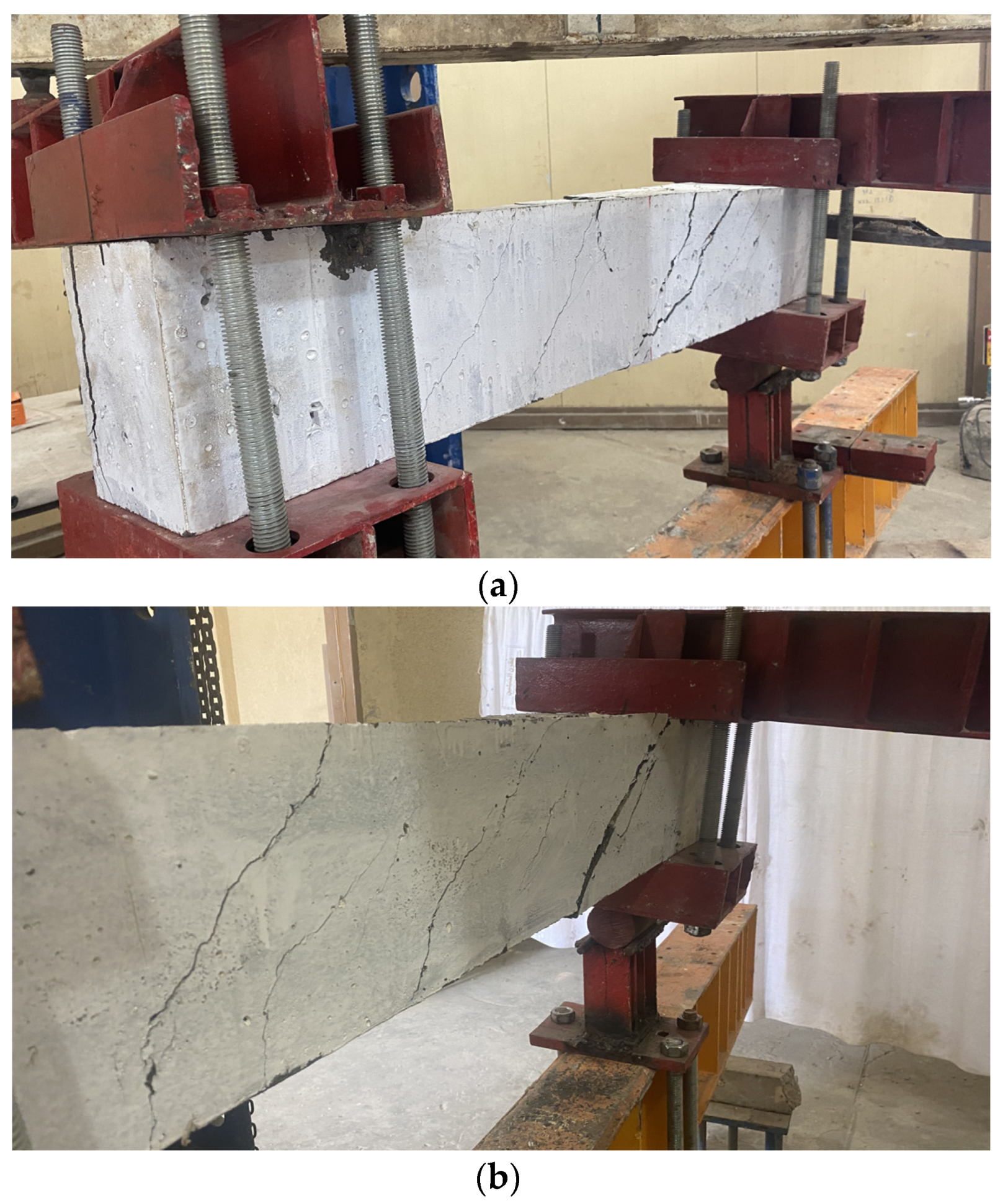
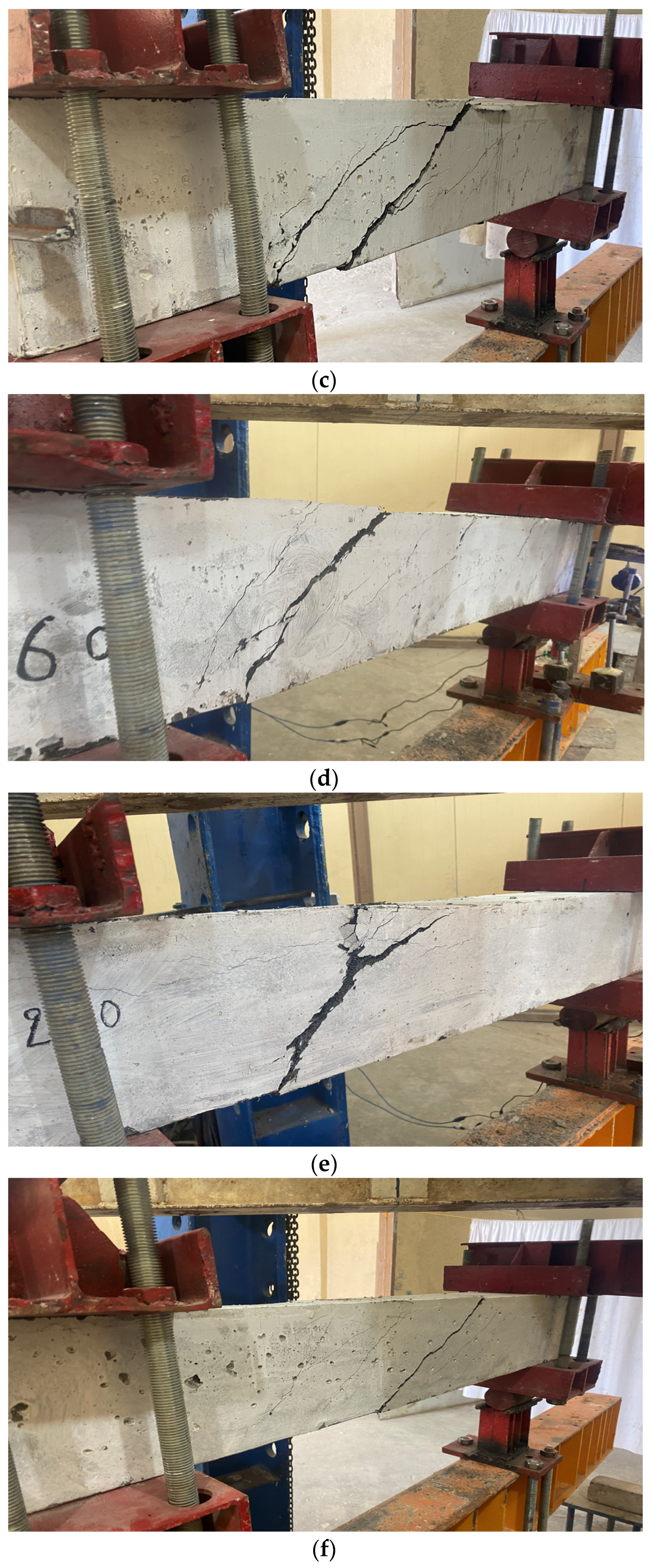

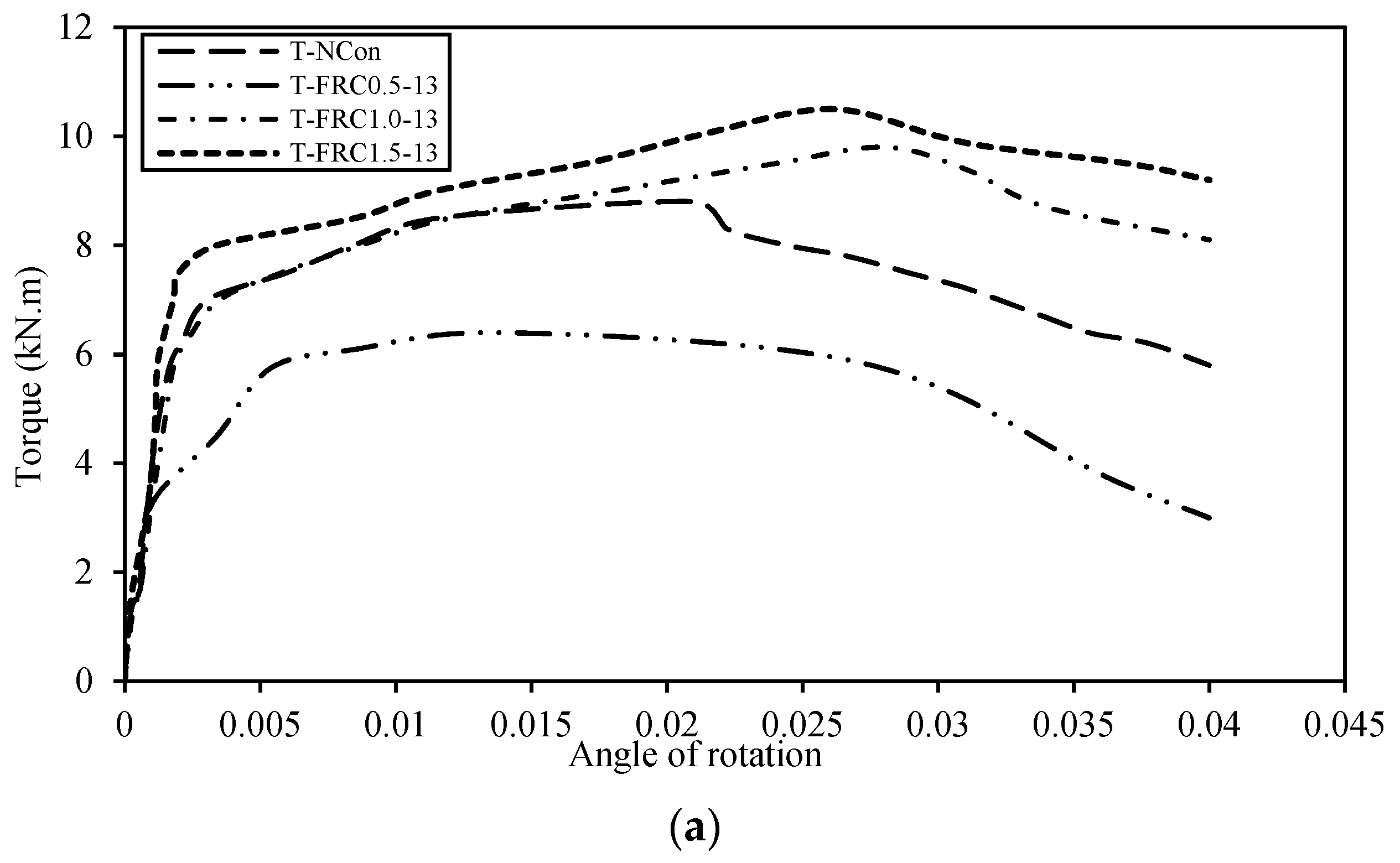

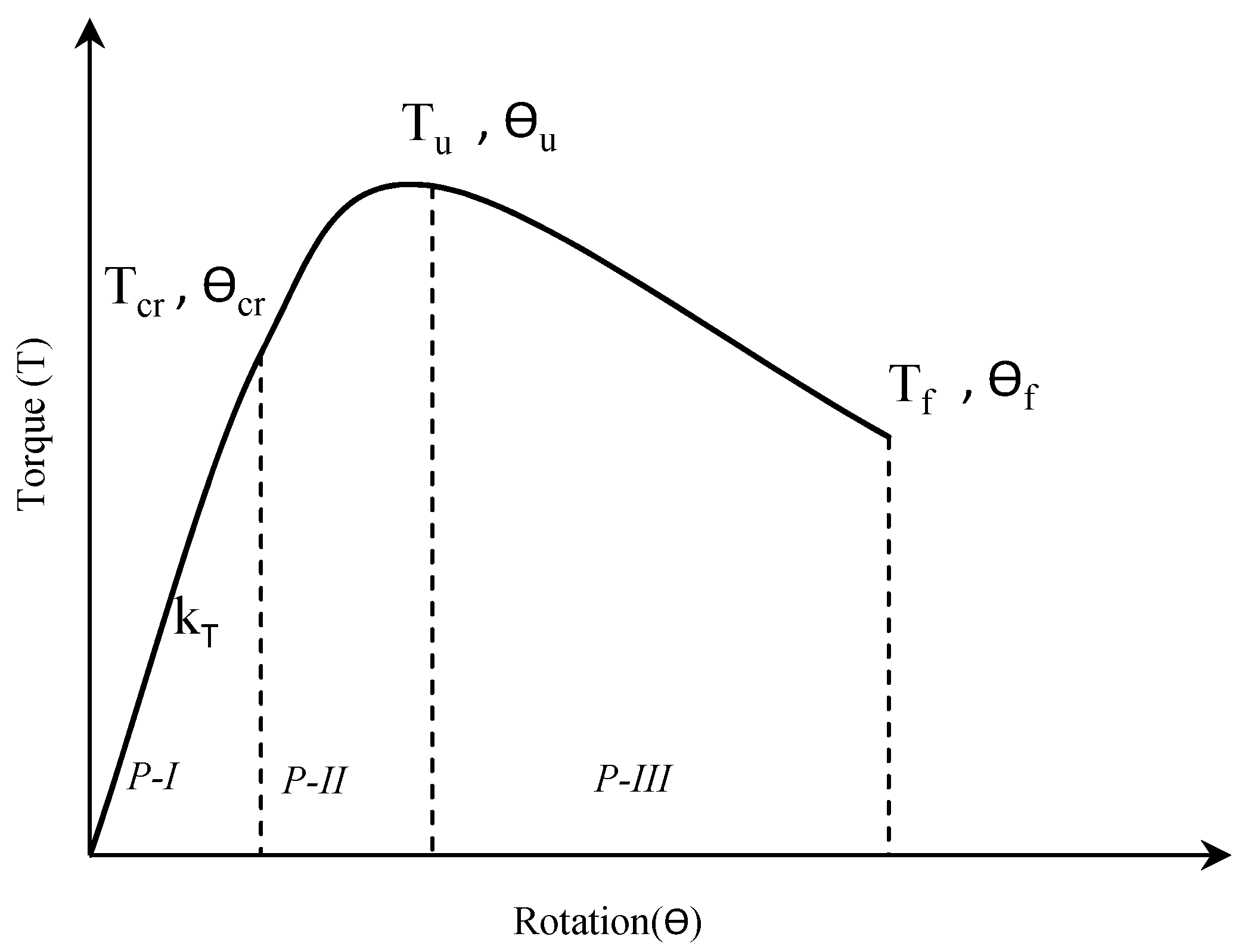
| Sample ID | Fiber Dosage Vf (%) | Fiber Length (mm) |
|---|---|---|
| T-NCon | 0 | 0 |
| T-FRC0.5-13 | 0.5 | 13 |
| T-FRC1.0-13 | 1.0 | 13 |
| T-FRC1.5-13 | 1.5 | 13 |
| T-FRC0.5-35 | 0.5 | 35 |
| T-FRC1.0-35 | 1.0 | 35 |
| T-FRC1.5-35 | 1.5 | 35 |
| T-FRC0.5-60 | 0.5 | 60 |
| T-FRC1.0-60 | 1.0 | 60 |
| T-FRC1.5-60 | 1.5 | 60 |
| Fiber | Diameter (mm) | Length (mm) | L/D | Tensile Strength (MPa) |
|---|---|---|---|---|
| Hook SF (H13) | 0.20 | 13 | 65 | 2500 |
| Hook SF (H35) | 0.55 | 35 | 64 | 900–2200 |
| Hook SF (H60) | 0.90 | 60 | 67 | 900–2200 |
| Sieve Size (mm) | Cumulative Passing % | % Passing of the Overall Limit of ASTM C33-03 [37] |
|---|---|---|
| 9.5 | 100 | 100–100 |
| 4.75 | 98 | 95–100 |
| 2.36 | 89 | 80–100 |
| 1.18 | 74 | 50–85 |
| 0.6 | 39 | 25–60 |
| 0.3 | 12 | 5–30 |
| 0.15 | 2 | 0–10 |
| Sieve Size (mm) | Cumulative Passing % | % Passing of the Overall Limit of ASTM C33-03 [37] |
|---|---|---|
| 25 | 100 | 100 |
| 19 | 100 | 90–100 |
| 12.5 | 80 | 40–85 |
| 9.5 | 37 | 10–40 |
| 4.5 | 4 | 0–15 |
| Compound Composition | Chemical Composition | Percentage by Weight | Limits of IQS No. 5/1984 [36] |
|---|---|---|---|
| Lime oxide | CaO | 63.4 | ------------ |
| Silica dioxide | SiO2 | 18.7 | ------------ |
| Alumina oxide | Al2O3 | 3.8 | ------------ |
| Iron oxide | Fe2O3 | 3.86 | ------------ |
| Lime saturation factor | LSF | 0.873 | 0.66–1.02 |
| Magnesia oxide | MgO | 0.43 | ≤5.00% |
| Tricalcium aluminate | C3A | 1.714 | ------------ |
| Sulfate trioxide | SO3 | 2.24 | ≤2.5% if C3A ≤5% |
| Loss on ignition | LOI | 2.2 | ≤2.8% if C3A >5% |
| Insoluble residue | IR | 0.89 | ≤1.50% |
| Physical Properties | Test Results | Limits of IQS No.5/1984 [36] | |
|---|---|---|---|
| Fineness (Blaine) (m2/kg) | 280 | ≥230 | |
| Time of setting (Vicat) (minutes) | Initial time | 98 | ≥45 |
| Final time | 406 | ≤600 | |
| Compressive strength for cement paste cube mold (50 mm) (MPa) | 3 days | 22.07 | ≥15 |
| 7 days | 35.23 | ≥23 | |
| Material | Quantity |
|---|---|
| Cement (kg·m−3) | 480 |
| Fine aggregate (kg·m−3) | 784 |
| Coarse aggregate (kg·m−3) | 832 |
| Water (kg·m−3) | 216 |
| Mix ID | Slump (mm) | COV % | Diff. (%) | Compressive Strength (MPa) | COV % | Diff. (%) | Tensile Strength (MPa) | COV % | Diff. (%) | Flexural Strength (MPa) | COV % | Diff. (%) | Brittleness Ratio |
|---|---|---|---|---|---|---|---|---|---|---|---|---|---|
| Con. | 128 | 4.10% | 0% | 34.25 | 3.62% | 0% | 2.68 | 6.25% | 0% | 3.32 | 5.24% | 0% | 10.3 |
| H13-0.5 | 120 | 4.70% | −6% | 40.32 | 3.35% | 18% | 4.22 | 3.25% | 57% | 5.67 | 3.66% | 71% | 7.1 |
| H13-1.0 | 95 | 3.80% | −26% | 45.36 | 4.36% | 32% | 5.47 | 5.14% | 104% | 6.15 | 4.82% | 85% | 7.4 |
| H13-1.5 | 90 | 5.20% | −30% | 51.2 | 8.54% | 49% | 6.45 | 4.55% | 141% | 8.25 | 8.25% | 148% | 6.2 |
| H35-0.5 | 109 | 6.10% | −15% | 38.44 | 6.27% | 12% | 3.41 | 8.36% | 27% | 4.81 | 6.32% | 45% | 8.0 |
| H35-1.0 | 96 | 2.40% | −25% | 42.33 | 5.62% | 24% | 5.22 | 6.54% | 95% | 5.86 | 7.22% | 77% | 7.2 |
| H35-1.5 | 87 | 4.60% | −32% | 49.65 | 7.62% | 45% | 6.25 | 2.55% | 133% | 7.89 | 3.66% | 138% | 6.3 |
| H60-0.5 | 102 | 5.00% | −20% | 36.14 | 3.52% | 6% | 3.1 | 4.45% | 16% | 4.12 | 5.39% | 24% | 8.8 |
| H60-1.0 | 90 | 3.60% | −30% | 40.25 | 5.51% | 18% | 4.25 | 6.33% | 59% | 5.24 | 4.15% | 58% | 7.7 |
| H60-1.5 | 82 | 6.10% | −36% | 45.43 | 4.62% | 33% | 6.33 | 4.32% | 136% | 7.68 | 7.32% | 131% | 5.9 |
| Sample ID | First Cracking | Ultimate Stage | (kN m) | ||
|---|---|---|---|---|---|
| Torque (kN·m) | Rotation (rad) | Torque (kN·m) | Rotation (rad) | ||
| T-NCon | 3.5 | 0.0022 | 8.8 | 0.021 | 1590 |
| T-FRC0.5-13 | 4.5 | 0.003 | 6.4 | 0.013 | 1500 |
| T-FRC1.0-13 | 5.2 | 0.0035 | 9.8 | 0.028 | 1485 |
| T-FRC1.5-13 | 6.7 | 0.0041 | 10.5 | 0.026 | 1634 |
| T-FRC0.5-35 | 3.6 | 0.0022 | 5.4 | 0.0024 | 1636 |
| T-FRC1.0-35 | 4.8 | 0.0031 | 9.4 | 0.026 | 1548 |
| T-FRC1.5-35 | 6.5 | 0.0043 | 11.6 | 0.028 | 1512 |
| T-FRC0.5-60 | 3.5 | 0.0023 | 5.1 | 0.0025 | 1522 |
| T-FRC1.0-60 | 3.9 | 0.0024 | 9.2 | 0.031 | 1625 |
| T-FRC1.5-60 | 6.1 | 0.0038 | 12.4 | 0.043 | 1605 |
| Sample Identification | Torsional Toughness (kN·m·rad) | |||
|---|---|---|---|---|
| P-I | P-II | P-III | Total | |
| T-NCon | 0.007 | 0.172 | 0.12 | 0.299 |
| T-FRC0.5-13 | 0.007 | 0.07 | 0.135 | 0.212 |
| T-FRC1.0-13 | 0.008 | 0. 228 | 0.1 | 0.336 |
| T-FRC1.5-13 | 0.007 | 0.229 | 0.13 | 0.366 |
| T-FRC0.5-35 | 0.007 | 0.007 | 0.033 | 0.047 |
| T-FRC1.0-35 | 0.003 | 0.212 | 0.12 | 0.335 |
| T-FRC1.5-35 | 0.006 | 0.263 | 0.13 | 0.399 |
| T-FRC0.5-60 | 0.007 | 0.007 | 0.002 | 0.016 |
| T-FRC1.0-60 | 0.025 | 0.236 | 0.053 | 0.314 |
| T-FRC1.5-60 | 0.028 | 0.397 | 0.211 | 0.636 |
| Sample Identification | Torsional Ductility μ |
|---|---|
| T-NCon | 9.07 |
| T-FRC0.5-13 | 4.12 |
| T-FRC1.0-13 | 7.60 |
| T-FRC1.5-13 | 6.02 |
| T-FRC0.5-35 | 1.04 |
| T-FRC1.0-35 | 7.97 |
| T-FRC1.5-35 | 6.19 |
| T-FRC0.5-60 | 1.03 |
| T-FRC1.0-60 | 10.27 |
| T-FRC1.5-60 | 12.75 |
Disclaimer/Publisher’s Note: The statements, opinions and data contained in all publications are solely those of the individual author(s) and contributor(s) and not of MDPI and/or the editor(s). MDPI and/or the editor(s) disclaim responsibility for any injury to people or property resulting from any ideas, methods, instructions or products referred to in the content. |
© 2023 by the authors. Licensee MDPI, Basel, Switzerland. This article is an open access article distributed under the terms and conditions of the Creative Commons Attribution (CC BY) license (https://creativecommons.org/licenses/by/4.0/).
Share and Cite
Jaber, M.H.; Abd Al-Zahra, B.I.; Ibrahim, A.A.; Hassan, R.F.; Al-Salim, N.H.; Hussein, H.H. Exploring the Effect of Varying Fiber Dosages as Stirrup Substitutes in Torsion-Loaded Concrete Beams. Buildings 2023, 13, 1865. https://doi.org/10.3390/buildings13071865
Jaber MH, Abd Al-Zahra BI, Ibrahim AA, Hassan RF, Al-Salim NH, Hussein HH. Exploring the Effect of Varying Fiber Dosages as Stirrup Substitutes in Torsion-Loaded Concrete Beams. Buildings. 2023; 13(7):1865. https://doi.org/10.3390/buildings13071865
Chicago/Turabian StyleJaber, Muna H., Bilal I. Abd Al-Zahra, Ayoob A. Ibrahim, Rafea F. Hassan, Nabeel H. Al-Salim, and Husam H. Hussein. 2023. "Exploring the Effect of Varying Fiber Dosages as Stirrup Substitutes in Torsion-Loaded Concrete Beams" Buildings 13, no. 7: 1865. https://doi.org/10.3390/buildings13071865





